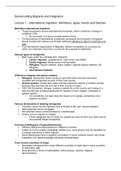Samenvatting Migrants and Integration
Lecture 1 - International migration; definitions, types, trends and theories
Definition international migration:
‘Those movements across international boundaries, which constitute a change of
residence’ (UN).
So not tourist, it is about a longer period of time.
For the purpose of international comparison permanent and long-term immigrants
should include both citizens and foreigh nationals intending to stay for more than one
year.
The International Organization of Migration defines immigration as a process by
which non-nationals move into a country for the purpose of settlement.
Various types of immigrants:
Main types under the umbrella term ‘migrants’:
1. Labour migrants: ‘guestworkers’, high-versus low-skilled.
2. Family migrants: family reunion and formation.
3. Refugees: Asylum seekers, status holders, rejected asylum seekers; UN
refugees.
4. International students.
Difference refugees and asylum seekers:
Refugees: fleeing their home country to save their lives and who have been
accepted and recognised as such in their host country.
Asylum seekers: people who make a formal request for asylum in another country
because they fear their life is at risk in their country of origin.
1951 UN Convention, refugee: a person outside his or her country and ‘owing to a
well-founded fear of being persecuted for reasons of race, religion, nationality or
political opinion’.
It is sometimes not clear what the reason is to migrate, sometimes more
reasons are there.
Various dichotomies in labeling immigrants.
Voluntary versus forced mightans (due to threats to life, war, natural disaster).
Self-supported versus smuggled.
Documented versus undocumented (or unauthorised).
Orderly versus irregular (or illegal).
These categories are not clear cut, people can also be both (e.g. there can be
documented illegal immigrants).
Concerns labeling/use of types/dichotomies.
Different definitions/interpretations in different countries.
Labels do not fit complex (changing) realities (e.g. some person may be classified as
a refugee and family or labor migrant.
Some labels/types have a negative connotation in some contexts (which may hinder
integration and disacknowledge individual characteristics).
From various countries of origin.
Nowadays immigrants from many different countries of origin (co) in many countries
of destination (cd).
More diversity in terms of nationalities, ethnic groups, cultures, religious
denominations.
, Any differences in time of arrival: some immigrant groups have a relatively longer
history in cd due to some special circumstances such as decolonisation, war,
recruitment of guest workers and international treaties (e.g. EU).
What are/were the main migration routes?
Part 2 - Trends in migration.
Migration routes in the 18th century:
Migration routes at the beginning of the 21st century:
Intracontinental/internal migration has increased.
Migration routes of refugees to Europe in 2015; European migrant crisis 2015:
Trend in flow of migrant types in the Netherlands:
,Actual trends in migration to the NL since 2000:
Family migration is the main type in numerical terms.
Asylum migration volume fluctuated considerably.
Reduced to less than one third between 2000 and 2009.
Increased to an all time record in 2014 and 2015.
Strong increase of labor migration (mainly for EU; Poles, Germans).
Strong increase of international students (mainly from EU; Germans).
Migration data; different ways of collecting data:
Population registers (OECD, EUROSTAT).
Administrative sources (visas, residence permits).
Border controls (entry and departure).
Household surveys (e.g. census, smaller scale surveys).
Interviews.
Main migration data sources:
IOM: https://www.iom.int/
IOM data portal: https://migrationdataportal.org/data?i=stock_abs_&t=2019
OECD, database on immigrants in OECD countries:
http://www.oecd.org/els/mig/oecdmigrationdatabases.htm
UNHCR, database on refugees: http://www.unhcr.org/cgi-bin/texis/vtx/home
Eurostat (EU): http://ec.europa.eu/eurostat/data/database
CBS (NL); Statline, population: https://opendata.cbs.nl/statline/#/CBS/en/
Migration data limitations and concerns:
Sometimes it is difficult to compare stocks or flow across countries.
Different definitions (e.g. foreign- born and foreign nationals) and way of data-
collection (e.g. census and registration data).
Stock: how many people with a migration background are at one moment in a
country.
Flow: how many people are migrating to and from one country.
Illegal/irregular immigrants are not included in official data sources (in some cases
based on estimations).
Mainly ‘Western countries (OECD) collect migration data in a systematic way
(allowing cross-national comparisons).
Only a few (comparative) survey studies focus on explanatory factors. These studies
often measure intention to migrate and not actual migration (these two are not
necessarily correlated).
, Part 3 - Theories on migration patterns.
Migration theories; explanations at three different levels of analysis.
1. Micro-level: characteristics of individuals.
2. Meso-level: characteristics of migrant networks or households.
3. Macro-level: characteristics of countries (push factors in co; pull-factors in cd).
Migration theories; five main theories.
1. Neo-classical economics theory.
Main assumption: people are rational; individuals move to where they will get
the most gain. This is an investment (migration) in human capital (training,
education, skills one possesses/learns).
Macro level: push-pull approach.
Main explanatory variables:
Income/wage differential (cd - co).
Unemployment differential (or employment cd).
Some recent studies apply newer versions of this theory include a broader
range of push- and pull factors (e.g. weather, nature).
Micro-level: cost-benefit analysis.
Main explanatory variables:
Expected income (differential).
Likelihood of employment.
But, people are not alone, they have to keep in mind others in making
decisions.
2. New economics theory.
Main assumption: migration decisions are taken by larger units of people (e.g.
families, households, communities) in order to minimize risk of household
income.
Focus on co (i.e. push factors).
Migration decisions are taken by the household/family (i.e. individual actors
may not prefer to migrate).
Notion of relative deprivation (i.e. reference group is other
families/communities in co).
Main explanatory variables:
Low/no access to capital (i.e. deficiency of insurance, credit and
consumer market).
Lack of social security.
High transaction costs (e.g. interest rates).
3. Segmented (dual) labor market theory.
Main assumption: industrious countries have an inherent demand for
‘immigrant labor’.






